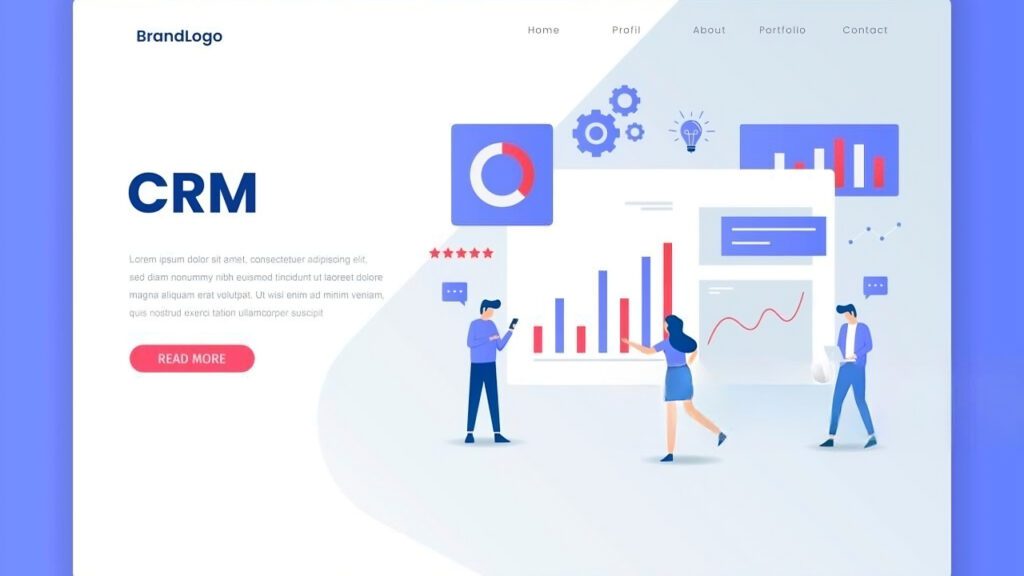
Customers remember how you make them feel, not just what you sell. As your pipeline expands, spreadsheets and generic tools break under the weight of details, handoffs and deadlines. That is when a custom crm development becomes a strategic lever.
With a tailored platform, you align screens to your real process, tie every touch to a measurable outcome and give your teams a shared source of truth.
This guide explains what a modern CRM should include, how to plan the rollout, and how to choose the right partner without costly detours. You will learn evaluation criteria, implementation steps and the metrics that prove value so your investment in custom crm development pays back fast.
Table of Contents
ToggleWhat Is CRM
A customer relationship management platform centralizes contacts, activities, deals, renewals and service. Most off the shelf products solve common needs. Still, every business has a unique sales motion, a unique service playbook and unique rules for pricing and approvals.
Custom crm development connects software to that reality. When your screens mirror your steps, adoption rises, data becomes trustworthy and insight gets sharper. Teams stop fighting the tool and start using it as a daily hub.
Why Custom CRM Development Is a Strategic Advantage
Leaders do not buy software. They buy outcomes. The outcomes you want are faster cycles, higher win rates, accurate forecasts and happier customers. Custom crm development supports those outcomes in five concrete ways.
- Fit to your process so handoffs are crisp and next steps are obvious.
- Automation that removes manual work and missed reminders.
- Visibility from marketing through finance so everyone sees the same truth.
- Reporting that matches executive questions instead of generic charts.
- Integrations that reduce duplicate entry and error.
FACT: Forrester has shown that tightly integrated CRM programs improve forecasting accuracy and sales productivity by meaningful margins.
Core Features to Prioritize
The best programs start focused. Use these building blocks when you scope custom crm development.
1. Lead and contact management
Capture leads from forms, chat, phone and events. Store a complete profile with consent, preferences, and communication history. Segment by industry, tier and lifecycle stage so outreach is relevant.
2. Pipeline and opportunity tracking
Mirror the real stages you use. Define entrance and exit criteria. Record primary competitors, decision roles and risks. Provide playbooks that suggest actions like scheduling a demo or sending a case study.
3. Task and activity management
Give each user a simple home view that highlights due activities. Allow email, call notes, and meetings to post automatically so managers see the real picture without nagging.
4. Quote, order and renewal flows
If you sell subscriptions or contracts, include pricing rules, approvals, and renewal timelines. Tie forecasts to line items so revenue projections are trusted.
5. Marketing and service handoffs
Create shared views so marketing sees pipeline impact and service sees promises made during sales. This reduces escalations and gives customers consistent experience.
6. Dashboards and analytics
Executives briefly need clarity. Build dashboards for the board, for sales leaders, and for individual reps. Show conversion rates, cycle time, forecast accuracy and churn risk. Allow drill down to the underlying records.
7. Mobile access
Field teams should log notes with one tap. Prioritize fast load time and offline capture. Voice to text speeds adoption.
8. Integrations
Connect email and calendars, accounting, ERP, commerce, quoting tools and data warehouses. A seasoned crm developer plans secure connectors and monitors them as APIs evolve.
Launch a minimal release fast, then add modules in short sprints. Momentum builds trust and yields better feedback, which sharpens the next round of custom crm development.
Use Cases and Industry Examples
1. Retail and e-commerce
Track browsing and purchase history, segment audiences, and trigger personalized campaigns. Service teams can view orders, returns and loyalty status without switching tabs.
2. SaaS and subscriptions
Manage trials, product usage, renewals and expansions. Forecast recurring revenue, flag accounts at risk and coordinate success playbooks.
3. Professional services
Unify sales, staffing, delivery and billing. Match skills to projects, monitor utilization, and keep scope changes visible to account managers.
4. Manufacturing and distribution
Link channels, price lists, inventory and warranty claims. Give account managers a single view across quotes, shipments, and service visits.
5. Healthcare and life sciences
Protect sensitive data while supporting referral tracking, outreach and field engagement with providers. Ensure audit trails and role-based access.
6. Education and nonprofits
Manage applicants, donors, volunteers and events with targets and dashboards that show progress against mission goals.
Start in one department, then extend. A focused first win proves the value of custom crm development and reduces risk.
Comparison Table: Off the Shelf Versus Tailored
| Criteria | Off the shelf CRM | Custom approach |
| Workflow fit | Generic templates | Built around your motions |
| User adoption | Users adapt to software | Software adapts to users |
| Integration depth | Vendor menu | Any required connection |
| Reporting | Fixed options | KPIs and drill downs you define |
| Scalability | Plan limits | Scales with data and teams |
| Total cost over three years | Lower entry fee | Higher ROI through fit |
How To Choose a CRM Software Development Company
The partner you select will shape the outcome more than any feature list. Use this framework when you evaluate a crm software development company. Look for industry experience that matches your model, case studies with quantified results, mastery of integration patterns and a security posture that meets your obligations.
Ask for a named crm developer who will own the data model and integrations. Review milestones and pricing and confirm what happens after going live.
Vendor Selection Scorecard
| Criterion | Weight | Questions to ask |
| Industry expertise | High | Which similar clients have you served and what results did they report |
| Technical depth | High | How do you handle API changes and performance at scale |
| Design clarity | Medium | Can a rep complete key tasks in three clicks or fewer |
| Data migration | Medium | How will you clean, deduplicate, and map legacy data |
| Post launch support | High | What service levels do you guarantee after go live |
| Cultural fit | Medium | How do you collaborate with internal teams day to day |
The Role of Specialists
A capable consulting partner brings process design, project management, and change management. A capable crm developer brings judgment about data models, code quality and integration stability.
Together they reduce risk and shorten time to value. In complex programs you may also engage data engineers, QA analysts and adoption coaches. Align all contributors to a single backlog so work flows smoothly.
Implementation Roadmap and Checklists
- Discovery and alignment
Interview leaders and frontline users. Set goals, KPIs and must have use cases. Capture pain points and handoffs that hurt customers. - Requirements and architecture
Translate goals into user stories. Select platform, data model and integration patterns. The crm software development company can facilitate these workshops and document decisions. - Build and iterate
Develop in small increments. Demo weekly to a pilot group. Gather feedback and adjust. Keep a visible backlog so everyone sees priorities. Assign a senior crm developer to own integrations and performance. - Data preparation and migration
Profile current data. Fix duplicates and standardize fields. Plan a rehearsal migration and a final cutover with rollback options. - Testing and training
Run unit and integration tests, then user acceptance testing. Train by role with short sessions and practical exercises. Provide quick reference guides and in app tips. - Go live and hypercare
Launch during a low-risk window. Staff a response team for the first two weeks. Track issues, resolve, and celebrate early wins. Capture lessons for the next phase of custom crm development.
Adoption checklist
- Executive sponsor and project owner named
- Daily active use targets by role
- Incentives aligned with data quality
- In app guidance and short videos
- Feedback loop and change log published
Security, Compliance and Data Governance
Trust drives relationships. Treat security as a product feature. Include role-based access, audit logs, encryption in transit and rest and regional data residency where required. Establish retention rules and deletion workflows.
A careful crm developer also designs guardrails that prevent risky exports and enforces least privileged access. For regulated sectors, pick a partner that has passed audits in your industry.
Build Versus Buy and Budgeting
There is a spectrum from packaged too fully custom. The right choice depends on urgency, uniqueness, and budget. Use this matrix to align expectations.
| Approach | When it fits | Pros | Cons |
| Package with light configuration | You need speed and common features | Fast launch, lower cost | Limits on workflow fit and data model |
| Low code platform with custom modules | You want flexibility without starting from zero | Balanced speed and fit | Needs skilled admins and a hands on owner |
| Full custom build | You have unique processes and scale | Exact fit and control | Longer timeline and higher cost |
Total cost includes licenses, build effort, integration maintenance, change management, support and enhancements. Plan for the life of the system, not only the first release of custom crm development. A seasoned crm software development company will model these costs so finance can plan with confidence.
Budget Buckets and ROI
Plan for one time implementation and ongoing run costs. Typical buckets include discovery, build, data work, testing, training and hypercare. Ongoing costs cover hosting, support, enhancements, and license growth.
Tie each item to a value hypothesis and track results after launch. When a workflow saves minutes per lead, multiply by volume and by cost per hour. The case for custom crm development becomes clear. Over time, custom crms also reduce the hidden cost of workarounds and manual reentry.
The Human Side: Change Management
Technology only works when people use it. Communicate the why, not just the what. Involve users in design, pilot with champions and celebrate early wins. Provide short training, office hours, and micro learning.
Recognize clean data and complete activity capture in performance reviews. A supportive crm software development company will provide adoption playbooks and coaching so the change sticks.
Where Custom CRMs Shine
Many leaders begin with packaged tools and later discover limits. That is when custom crms step forward. You can model complex territories, multi brand catalogs, or service entitlements without awkward workarounds, can connect to niche systems that your industry depends on and can deliver dashboards that match the way your board reviews the business.
Custom crms create a single place where sales, service and finance trust the same numbers. When needs change, custom crm development adapts without unpleasant surprises.
How Specialists Add Speed
Even strong internal teams bring in partners for acceleration. A proven crm software development company arrives with playbooks for discovery, integration patterns and adoption.
A senior crm developer writes maintainable code, documents integrations, and mentors your staff so you can own the platform after launch. This blend of outside speed and inside ownership is a hallmark of successful programs.
Role Based Dashboards
| Role | What they see | Why it helps |
| Account executive | Today tasks, open deals by stage, next best actions | Keeps focus on progress and follow through |
| Sales manager | Team pipeline, forecast changes, coaching alerts | Enables timely coaching and clean commits |
| Service leader | Open cases by priority, backlog trend, satisfaction | Keeps response promises visible |
| Marketing lead | Lead sources, campaign influence, conversion | Connects programs to revenue impact |
| Finance | Bookings versus forecast, aging invoices, renewals | Aligns revenue expectations with cash flow |
Final Thoughts
Growth is the reward for consistent follow-through. The tools you give your teams either create flow or create friction. A thoughtful program that begins with a journey map, assigns a single owner and releases a small but complete slice will build momentum fast.
Choose a partner with proof in your industry, empower a senior technical lead, and keep the backlog tied to outcomes that leaders care about.
Train by role, listen to feedback and celebrate visible wins. Protect trust with strong governance so customers feel safe. Keep improving every quarter so your custom crm development remains the simplest way to do the right work at the right time.


